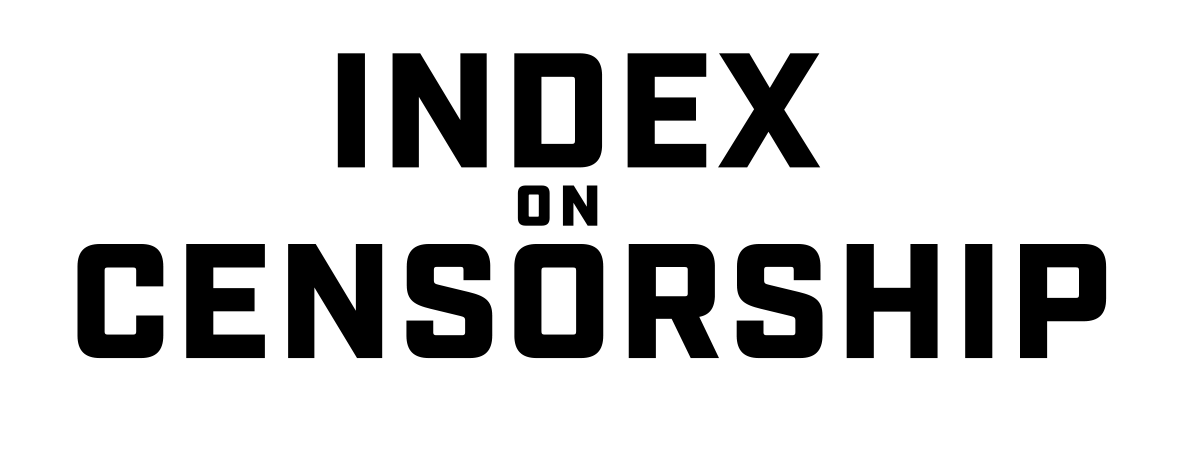15 Apr 2016 | About Index, Awards, Fellowship, Fellowship 2016, News and features
Words by Alessio Perrone and Sean Gallagher
Photos: Sean Gallagher
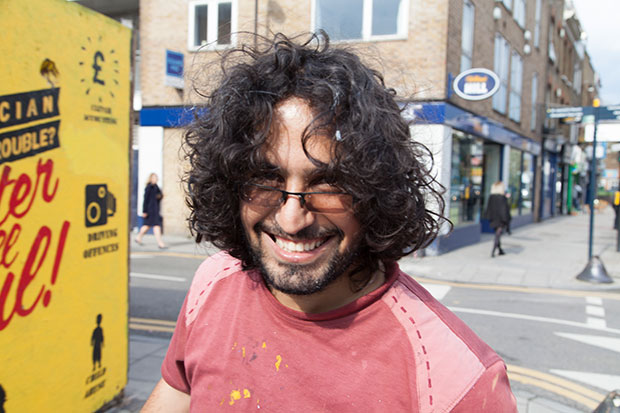
“I invite people like this: I just say – you paint now.” That’s how it works with street artist Murad Subay.
His murals grew from the frustration he felt as his homeland, Yemen, descended into chaos and factionalism. Amid the destruction and anger, Subay picked up his brush. With friends, he went out into the streets and began painting in broad daylight. Days passed, then people from the community joined him. All of them driven by their desire for peace amid Yemen’s civil war.
Since 2011 he’s created campaigns to encourage Yemenis to express their outrage at what their country has become. He and his collaborators have coloured walls, named the disappeared and marked ruins.
He always works during the day. It’s always part performance, part collaboration. Thursday 14 April was no different. Only the location had changed.
For his first mural outside Yemen, Subay took his brushes and paint to the corner of Hackney Road and Cremer Street to send a pointed message about the international community’s lack of humanity, especially toward his homeland. Even dogs are better than some of the global institutions and structures.
In London, to receive the 2016 Freedom of Expression Arts Award for his work, which Subay stressed is for Yemen. His acceptance speech was dedicated to the “unknown people who struggle to survive”.
Invited by Jay, the community curator of Art Under the Hood, Subay set up his equipment — with the help of new friends — and began transforming a hoarding into his vision using stencils he had laboured over since arriving on Saturday.
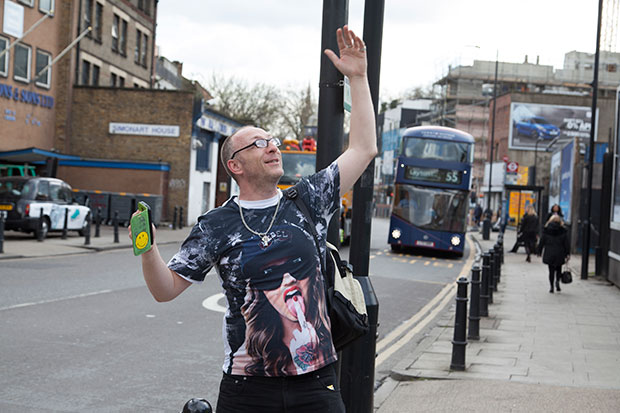
“I’m doing a sun dance.”
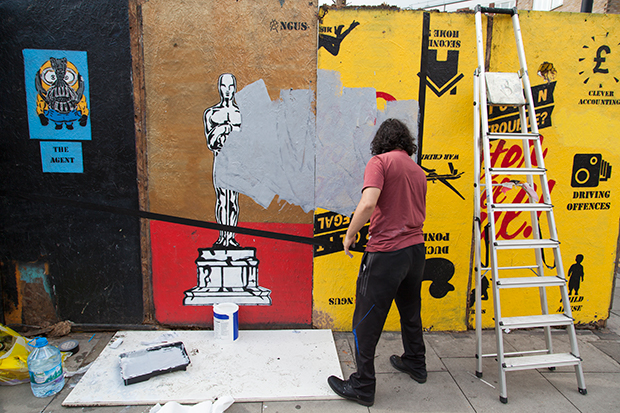
“I’m not the type of artist who zones out and thinks this is precious. It’s an ordinary thing for me”
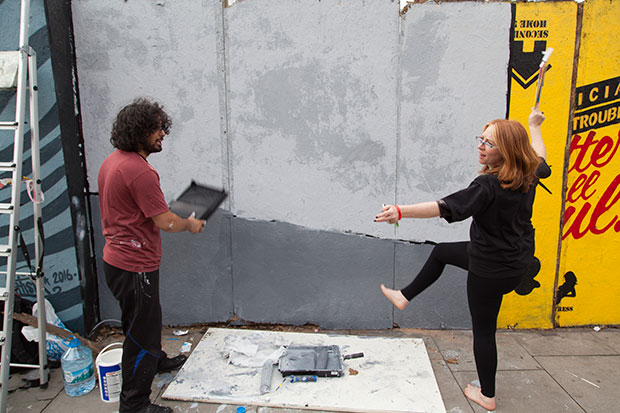
“How long will it take for it to dry?”
“In Sana’a, three minutes!” Then a few seconds later “Here, I don’t know”
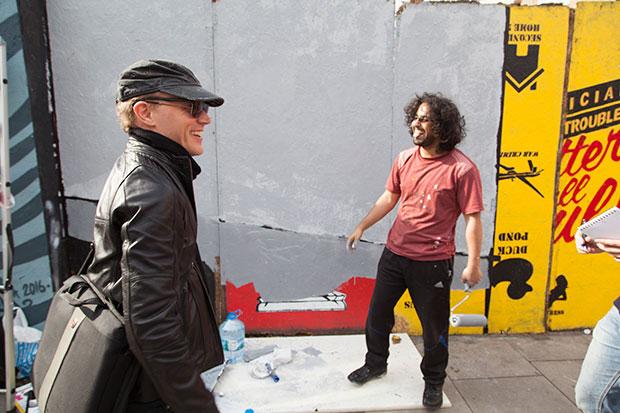
“Do you want me to do anything”
“Yes of course. Come here”
“Welcome to the holy state of Hackney, my friend. This is not a borough, not a city, it’s a state.”
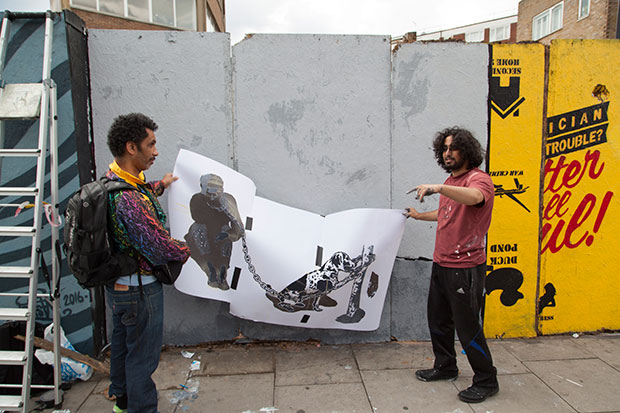
“I’ve worked on these stencils from time to time for four days. It’s hard to say how long it takes. Sometimes it takes three, four hours, other times five … Depends on what I do”
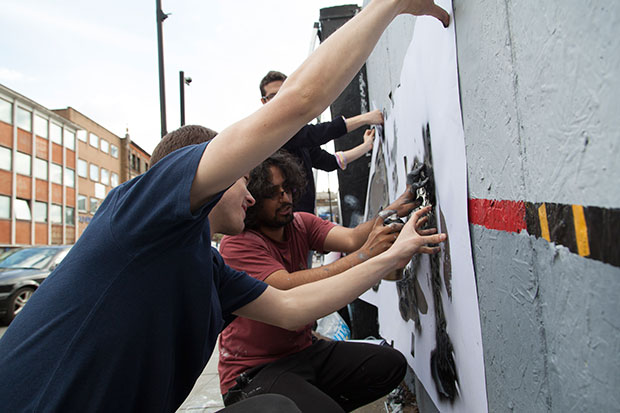
“First, try it on the cardboard to see how strong or light it is. Then press in the shape, light, not strong. Keep it at an angle close to the margins, so you can make sure you don’t spray outside the shape. Then perpendicular in the middle. Keep it light, light!”
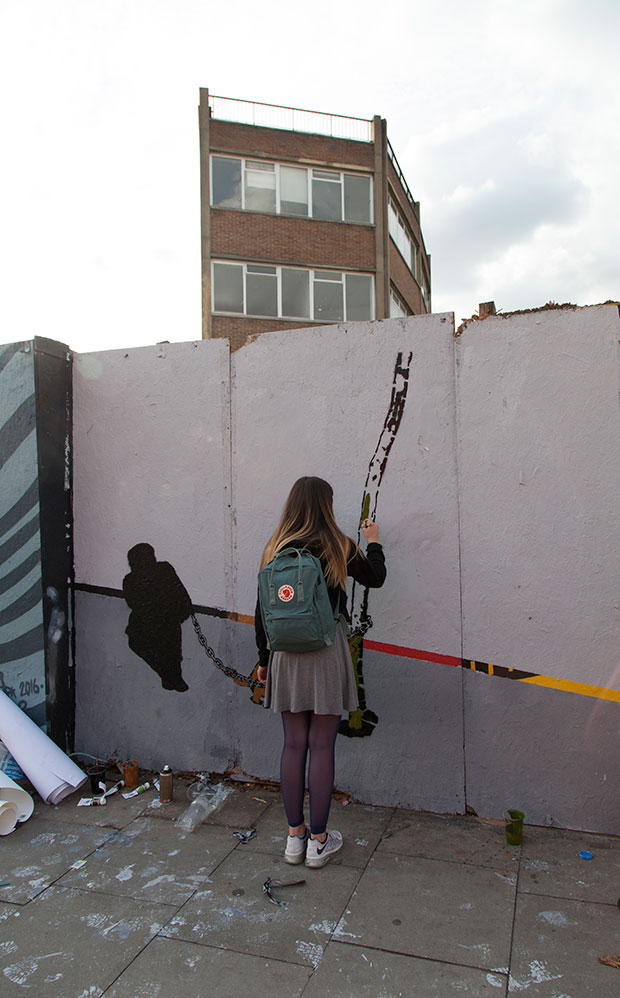
“Can I have a go?” a young woman asks.
“Yes of course!”
She stops for a moment, hesitant. Then she ends up staying until the very end. And in the end, Subay gives her, Éléa, the stencils when he finishes the mural.
“Do you paint?”
“A bit”
“Not a bit, you have to paint a lot! Painting is beautiful.”
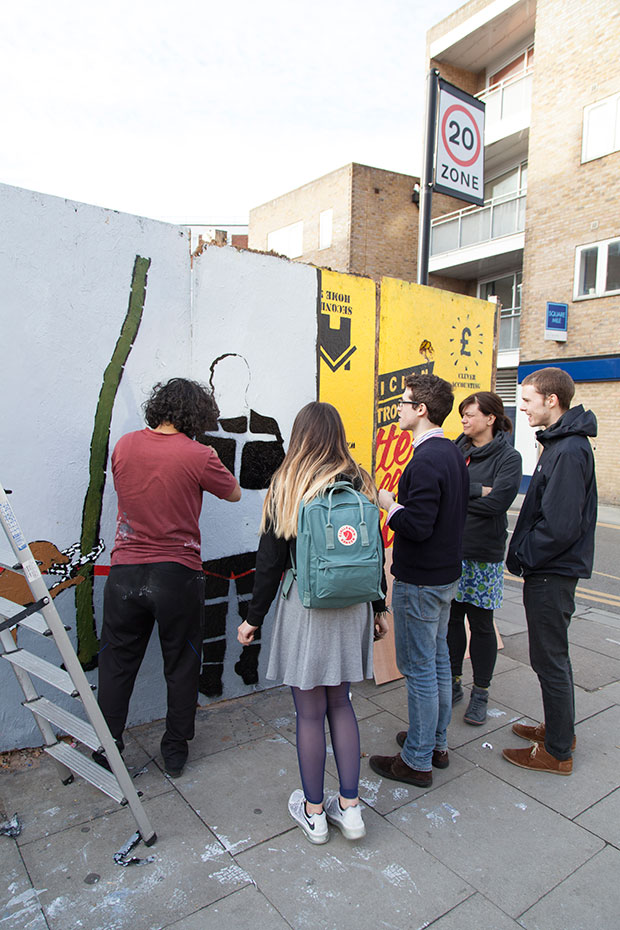
“They have artists in Yemen? First time I hear that!”
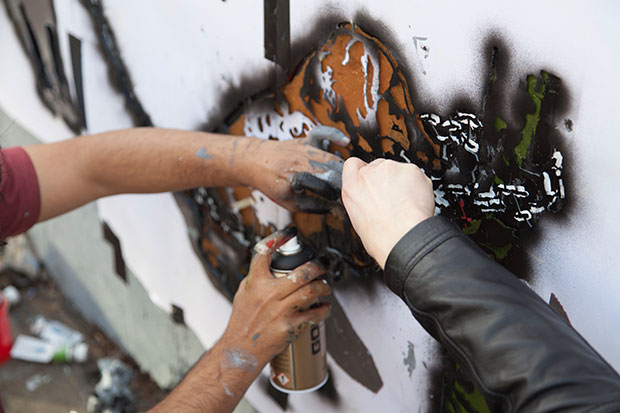
“You know how to spray right? Come and learn a bit!”
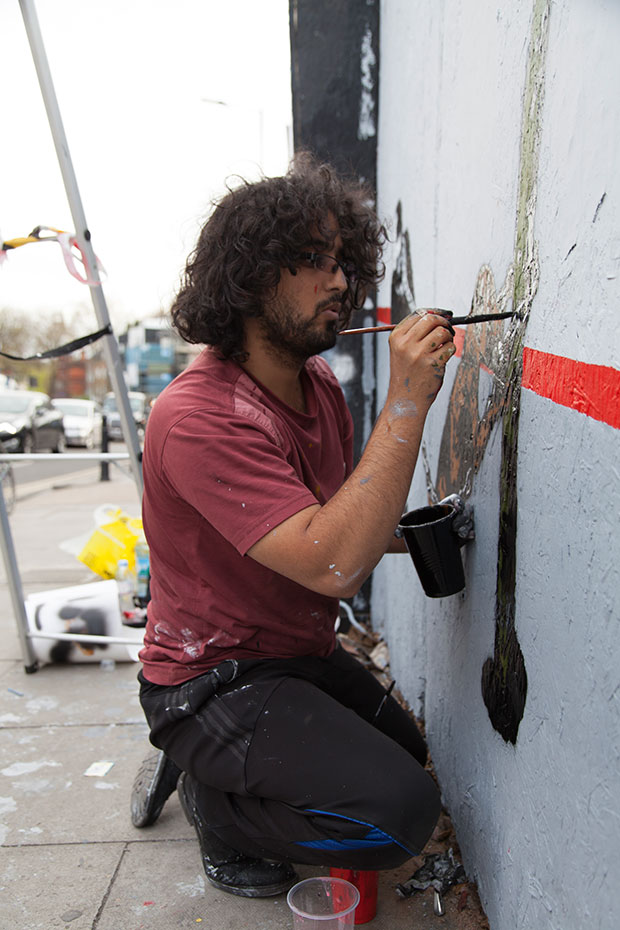
“When I started out, I was alone, and I did it all in one week. I am slow. In the beginning, I never thought people could join. But then they did. They say: ‘Oh look, the artist!’ And they join”
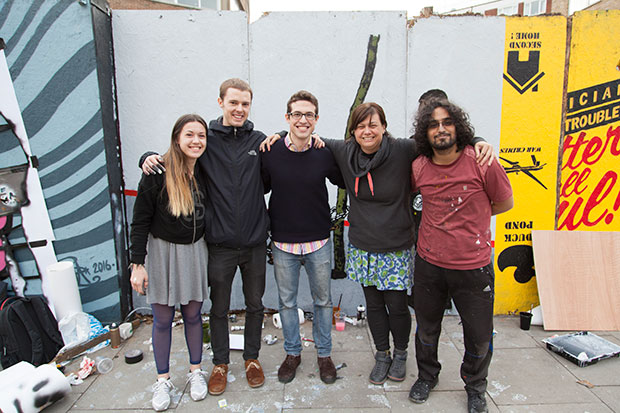
“These stencils, I made in Yemen. I staged a photo, printed it, then cut it out. That chained man is one of my relatives. He’s a very nice person. He jokes a lot and loves painting. I really like him. We work together a lot, on street art of course but also many different things.”
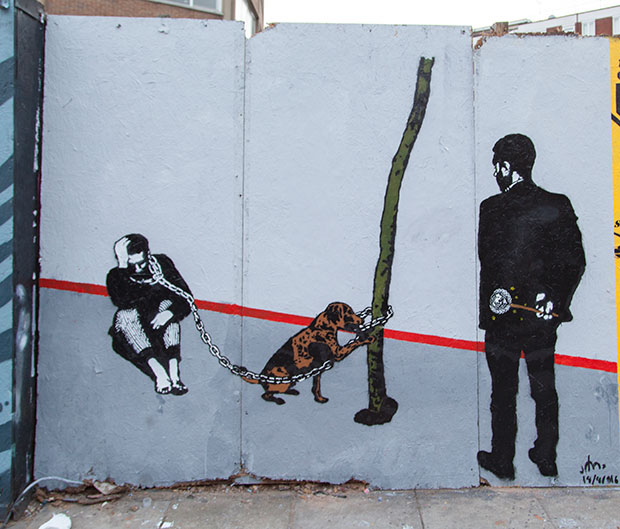
“It’s all about how the man is suffering. He’s not just Yemen or anybody in particular. It could be any man. The dog is trying to help, and is showing more kindness then the other man. The dog shows that it’s possible to help out, but the other man doesn’t want to do anything.”
18 Mar 2016 | Awards, Fellowship, Fellowship 2016, Middle East and North Africa, Yemen
In 2011, artist Murad Subay took to the streets of Yemen’s capital, Sana’a to protest the country’s dysfunctional economy and institutionalised corruption, and to bring attention to a population besieged by conflict. Choosing street art as his medium of protest, he’s since run five campaigns to promote peace and art, and to discuss sensitive political and social issues in society. Unlike many street artists, all his painting is done in public, during the day, often with passers-by getting involved themselves.
Since 2011, jihadist attacks and sectarian clashes have engulfed Yemen, and in 2015 a civil war began between two factions claiming to constitute the Yemeni government. The exiled Yemeni government, backed by a Saudi-led coalition stood against the Houthi militia, and those loyal to former president Ali Abdullah Saleh and backed by Iran.
In the last seven months the conflict has hit the already unstable country, leading to over 21 million people – 82 percent of the population – needing humanitarian assistance. In addition, a strong Al-Qaeda presence has drawn repeated drone strikes from the United States.
“Yemenis live under catastrophic conditions due to the conflicts, considering that they are already one of the poorest nations in the world,” Subay told Index. “They lack food, water and medicine, and they are in need of urgent humanitarian assistance.” With his art, Subay aims to highlight the situation in which millions of Yemenis find themselves in today.
Murad started his graffiti campaigns with The Walls Remember Their Faces, drawing the faces of Yemeni citizens who had been forcibly disappeared.
“This particular campaign meant so much to me,” he said. “I felt that I got closer to those people every time we painted their faces. Almost every week people came holding the picture of their long disappeared family member, so that we paint it on the walls.”
He then began Colour the Walls of Your Street, claiming back the bombed remains of Yemen’s capital, followed by 12 Hours in 2013. 12 Hours was an hour-by-hour series with each piece depicting one of 12 problems facing Yemen, including weapons proliferation, sectarianism, kidnapping and poverty. The project used social media to call Yemeni citizens to action, painting walls with messages about government and policy across Yemen’s capital.
His latest campaign Ruins was initiated in May 2015, in collaboration with artist Thi Yazen. The project involves them painting on the walls of buildings damaged by the war, to provide a memorial for the thousands of war victims, and to highlight war crimes.
Subay has faced pressure from the authorities, who have covered his work or stopped him from extending his campaigns to other towns. However ordinary Yemenis — including victims’ families — have gotten behind his campaigns by painting alongside Subay, or repainting pieces “scrubbed out” by authorities.
Murad Subay continues to shed light on the human cost of the war, taking his murals to other cities in Yemen, including Aden, Taizz, Ebb and Hodeidah.
16 Dec 2015 | Awards, Events, mobile, Press Releases
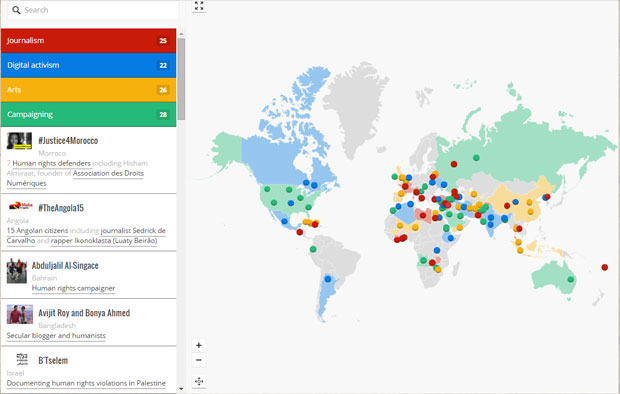
A graffiti artist who paints murals in war-torn Yemen, a jailed Bahraini academic and the Ethiopia’s Zone 9 bloggers are among those honoured in this year’s #Index100 list of global free expression heroes.
Selected from public nominations from around the world, the #Index100 highlights champions against censorship and those who fight for free expression against the odds in the fields of arts, journalism, activism and technology and whose work had a marked impact in 2015.
Those on the long list include Chinese human rights lawyer Pu Zhiqiang, Angolan journalist Sedrick de Carvalho, website Raqqa is Being Slaughtered Silently and refugee arts venue Good Chance Calais. The #Index100 includes nominees from 53 countries ranging from Azerbaijan to China to El Salvador and Zambia, and who were selected from around 500 public nominations.
“The individuals and organisations listed in the #Index100 demonstrate courage, creativity and determination in tackling threats to censorship in every corner of globe. They are a testament to the universal value of free expression. Without their efforts in the face of huge obstacles, often under violent harassment, the world would be a darker place,” Index on Censorship CEO Jodie Ginsberg said.
Those in the #Index100 form the long list for the Index on Censorship Freedom of Expression Awards to be presented in April. Now in their 16th year, the awards recognise artists, journalists and campaigners who have had a marked impact in tackling censorship, or in defending free expression, in the past year. Previous winners include Nobel Peace Prize winner Malala Yousafzai, Argentina-born conductor Daniel Barenboim and Syrian cartoonist Ali Ferzat.
A shortlist will be announced in January 2016 and winners then selected by an international panel of judges. This year’s judges include Nobel Prize winning author Wole Soyinka, classical pianist James Rhodes and award-winning journalist María Teresa Ronderos. Other judges include Bahraini human rights activist Nabeel Rajab, tech “queen of startups” Bindi Karia and human rights lawyer Kirsty Brimelow QC.
The winners will be announced on 13 April at a gala ceremony at London’s Unicorn Theatre.
The awards are distinctive in attempting to identify individuals whose work might be little acknowledged outside their own communities. Judges place particular emphasis on the impact that the awards and the Index fellowship can have on winners in enhancing their security, magnifying the impact of their work or increasing their sustainability. Winners become Index on Censorship Freedom of Expression Awards Fellows and are given support for the year after their fellowship on one aspect of their work.
“The award ceremony was aired by all community radios in northern Kenya and reached many people. I am happy because it will give women courage to stand up for their rights,” said 2015’s winner of the Index campaigning award, Amran Abdundi, a women’s rights activist working on the treacherous border between Somalia and Kenya.
Each member of the long list is shown on an interactive map on the Index website where people can find out more about their work. This is the first time Index has published the long list for the awards.
For more information on the #Index100, please contact [email protected] or call 0207 260 2665.
14 May 2014 | Middle East and North Africa, News and features, Yemen
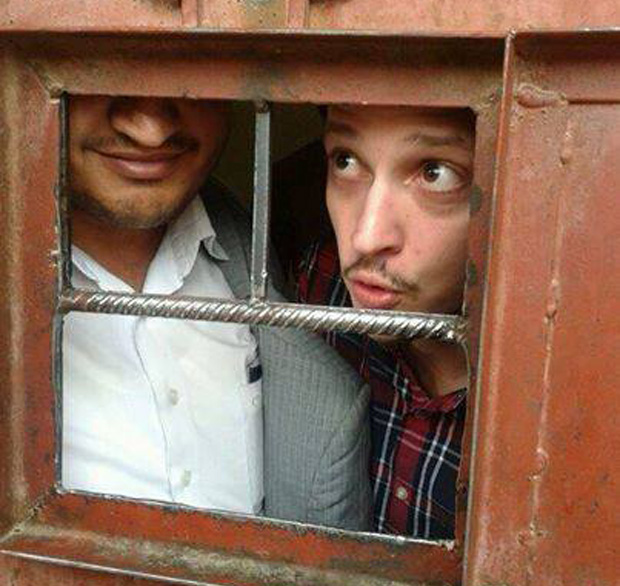
American journalist Adam Baron in jail. He was deported from Yemen last week. (Image: @almuslimi/Twitter)
Working in Yemen as a journalist can often feel like being an involuntary character in a clichéd Hollywood drama — a hybrid of a John le Carré novel and a Johnny English-style parody.
In over three and half years living in Yemen I’ve gone on the run from government agencies on four occasions. Looking back months later you either laugh or shake your head in despair at the surreal madness of it all.
One occasion involved a more than six-hour drive across part of rural Yemen popular for US drone strikes, with a local journalist alongside me. Exhausted and relieved, our successful getaway ended just before dawn.
Another was, in hindsight, rather more comical. As Yemen’s uprising intensified in April 2011, district security chief came knocking on the door in the middle of the night. He was looking for journalists and demanded copies of foreigners’ passports. It was a few weeks after soldiers had stormed the house of three foreign journalists who were then deported. The young, clandestine-revolutionary who guarded the apartment block where American journalist Jeb Boone and I were temporarily staying, managed to put the official off until the next day.
Under the cover of darkness we each packed a small rucksack of essentials: cameras, notebooks, and a change of clothes, while planning our escape to a friend’s house which had been left empty following the evacuation of the majority of the ex-pat community due to deteriorating security in Sana’a. As we made our furtive escape, creeping out of the gate in the early hours of the morning we walked straight into a truck full of soldiers parked outside the next-door neighbour’s gate. George Smiley wept.
The third almost ended in disaster. After writing a piece in January last year for The Times on Saudi Arabia’s involvement in America’s covert war in Yemen, on advice, I once again temporarily relocated in Sana’a amid fear of reprisals for my reporting. A couple of weeks after returning to my Old City home the taxi I was travelling in was ambushed outside the Ministry of Defence. A bullet smashed through the window next to my head, hissed through the hair of my driver but miraculously left both of us unharmed. Since then I have probably become the only woman in the world to convert their United Nude shoe bag into a gunshot trauma kit which I’ve since carried with me at all times.
But, as foreign journalists we have little if anything to fear. The worst that’s likely to happen to us, as American journalist Adam Baron found out during his deportation last week, is a 10-hour spell in jail wondering if we’re going to be given a few minutes to pack before being kicked out of the country we call home, without the possibility to return.
While we — the handful of foreign journalists based in Yemen — might have anxious moments once or twice a year, our Yemeni colleagues are constantly under threat. Yemen remains amongst the bottom 15 countries out of 180 in the world for press freedom. A Human Rights Watch report last September concluded that freedom of expression since President Abd-Rabbu Mansour Hadi took power in February 2012 has increased, but along with it, intimidation and violence against journalists has also risen. Yemen’s Freedom Foundation recorded 282 attacks and threats against journalists and media workers in 2013.
While Adam waited anxiously in jail last Tuesday, passport and phone confiscated, unease spread. Officials indicated that “other foreign journalists were next” my name was also mentioned. Not knowing if they’re coming to get you today, tomorrow, or at all, means that despite the relatively benign consequences, you are gripped with an almost unbearable sense of apprehension. Preparing for the worst I informed my editor at The Times in London and started to pack.
Three days later, still waiting, the madness felt like it was closing in. As the sunset over Sana’a on Friday evening one friend called to tell of gunfire and explosions next to his house. Meanwhile I sat in the protective darkness of my stairwell whispering into my phone as I heard the distant voices of two men banging on my front gate. Was this it? Was this the moment I would be forced to leave? My phone — on silent in case it was heard by those outside — lit up. Another friend had just narrowly avoided driving straight into a running gun battle in the south of the city. I tiptoed down the stairs in the dark and silently slid the two deadbolts across the large wooden door of the ancient Yemeni tower-house that is my home.
The irony is that while the ex-pat community goes into week two of lockdown in Sana’a and Western embassies close to the public due the increasing threat from al-Qaeda attacks, the most persistent threat to journalists on a daily basis is from the government and its intelligence agencies, not so-called militants.
After Adam was deported last week, for the first time, I decided not to run as I have too many times in the past. Without stopping and challenging what the government has done means the persecution of journalists will continue unabated.
There are just a small handful of foreign reporters based full-time in Yemen. Adam and I were the only ones accredited in a country where the government makes it almost impossible to live permanently as a foreign journalist with the correct paper work. Deporting unregistered journalists means no complaints can be made when individuals are thrown out.
As a legally operating reporter I had firm ground to stand on to support Adam and raise questions about why the government has chosen this moment to target him, and possibly me. Was this a personal vendetta against him? Or, was this a concerted effort by the state to remove witnesses? Those who may witness the consequences of a US-backed war currently being waged in the most significant military crackdown against al-Qaeda every carried out in Yemen.
The answers to those questions were partly answered by the manager of immigration who pulled me aside at Sana’a airport on Monday morning when I chose to leave Yemen of my own accord. I realised I’d had enough of the constant cycle of farcical drama, instigated by the state, that comes with living as a journalist in Yemen over three and a half years. I wanted it to stop. To take back control.
Despite the fact that my journalist visa is valid until February 2015, the immigration official began with “you can’t come back…” and ended with “it’s OK, you are allowed to leave now”. For the latter at least I was grateful.
The foreign media may not be welcome in Yemen, but if they are quietly trying to remove us then the greatest threat to be faced will be to domestic reporters. Over a snack of traditional sweet kataif pancakes and chilled apricot juice on my last day in Sana’a on Sunday, I sat with a Yemeni friend and fellow journalist. He acknowledge the need to step back from the madness. “The national security, they get to you,” he said tapping a finger against the side of his head. “You need to go home for some quiet time,” he added. “I got my quiet time…in prison.”
This article was posted on May 14, 2014 at indexoncensorship.org













